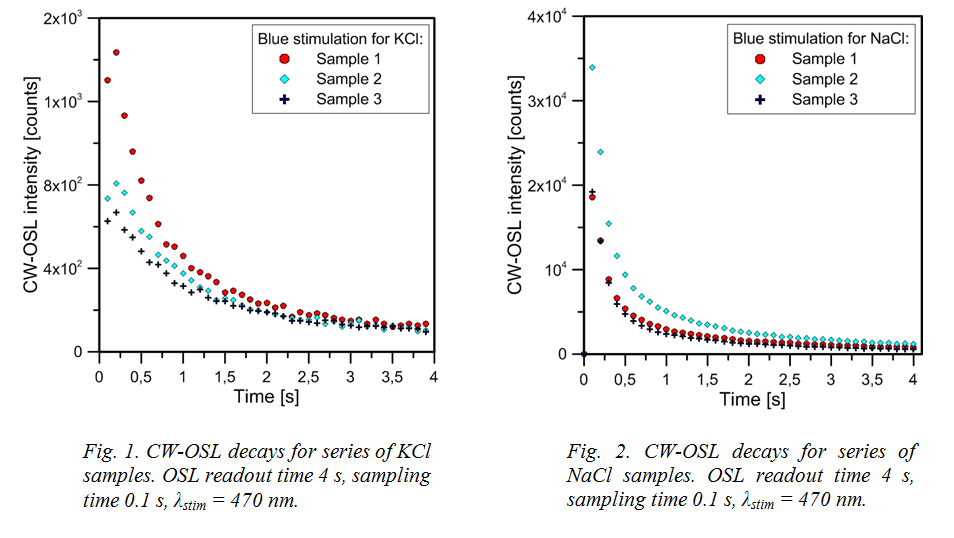Growing prevalence of radioactive isotope use in medicine and industry, as well as the possibility of dangerous radiation incidents resulting from malfunctions, or the potential risk of the nuclear weapon use, cause that radiological protection of people and environment is highly important. This aspect prompted us to search for cheap and commonly widespread materials which can by use as passive radiation detectors in places where standard radiation meters are not available. The sensitive luminescence method as Optically Stimulated Luminescence (OSL) can by applied in order to obtain information about dose absorbed by detector. Strong luminescence OSL signal observed from irradiated sodium and potassium chlorides makes these materials potentially interesting candidates for dosemeters. Nowadays potassium chloride was considered as X-ray imaging sensor and UV detector [1], whereas sodium chloride was studied for its apply in dating and dosimetry [2].
The OSL method belongs to radiation induced luminescence phenomena and consists of lighting detector with strong light in visible or infrared range. Crucial role during optical stimulation play defects of crystalline structure which correspond to localized energy levels inside the band gap. These levels act as stable traps for charge carriers excited during irradiation. The light of stimulation causes the release of charge carriers located in traps and, as a result of radiative recombination, subsequent luminescence emission. Typically, the amount of light emitted during stimulation is proportional to the previously absorbed dose by the detector.
This work presents investigation of reproducibility of OSL decays for beta irradiated chlorides using different wavelength of stimulation. The samples were prepared from analytical quality sodium chloride or potassium chloride material, which was dissolved in distillate water and recrystallized (with presence of daylight). The single-grain crystals were colorless with white inclusions and grain size of 1-2 mm and masses 2.3±0.1 mg. Irradiation were made using laboratory 90Sr/90Y b source with an activity of 37 MBq.
The equipment used for measurements was custom-made OSL reader ‘HELIOS-1’ [3] and its modified version ‘HELIOS-3’. The readers consist of interchangeable modules for stimulation (green, blue, IR) in the form LEDs with optical lenses. The stimulation in the ‘Helios 1’ reader was carried out using green LEDs (peak at 520-532 nm) and additional Schott filters GG495 and OG515 to cut-off short-wave light component below 500 nm. The stimulation in ‘Helios 3’ reader was made using blue LEDs (peak at 470 nm) with edge Schott filter GG455. Detection of luminescence was made by a modified integrated photon counting module H7360 (Hamamatsu) with quartz window, counter electronics and computer interface. Additional photosensor is applied in order to control the LEDs emission. Blue light emission (in the range 300-380 nm) can be detected as OSL signal using Schott UG11 filters. The reader is operated by the dedicated software on a PC. Using standard detectors Al2O3:C (manufactured by Landauer, USA) the readers achieve very good sensitivity at the level of 0.01 mGy.
After beta irradiation the samples were stimulated by light with constant intensity and the emitted luminescence signal was recorded during time of stimulation (so called CW-OSL technique). Fig. 1–2 show CW-OSL decays using blue light stimulation of NaCl and KCl crystals previously irradiated with dose equal 0.63 Gy. The shape of decays for both chlorides seems to be similar, whereas the beginner intensity of OSL signal is generally greater for NaCl than KCl crystals. We observed small dispersion of OSL signals for the series of crystals for each type of chlorides despite persisting an identical measurement conditions and masses of the samples. Comparison the OSL decays from chlorides is depicted in the fig. 3 and 4. The results show influence of stimulation wavelength on the OSL response. The different shapes of OSL decays from NaCl and KCl may indicate complex structure of traps in these materials and/or occurrence of traps population with different sensitivity to a specific wavelength of stimulation light.

Both NaCl and KCl crystals exhibiting strong OSL signal, are cheap and widely available. These features make them potential luminescent detectors. An important aspect in order to use the material in ionizing radiation dosimetry is the repeatability of the results. It is also significant for theoretical explanation of the luminescence mechanism in the material (kinetics of luminescence from NaCl and KCl are complex, there is no simple theoretical model expository them). With the purpose of obtaining repeatable results, it is necessary to comply with fixed conditions of sample preparation, irradiation, storage (e.g. time between excitation and readout) and readout parameters.
References
- Nanto K., MurayamaY., Usuda S., Taniguchi N., Takeuchi N., Optically Stimulated Luminescence in KCl:Eu Single Crystals, Radiation Protection Dosimetry, 47, (1993), 281-284.
- Bailey R.M., Adamiec G., Rhodes E.J., OSL properties of NaCl relative to dating and dosimetry, Radiation Measurements, 32, (2000), 717–723.
- Mandowski A., Mandowska E., Kokot L., Bilski P., Olko P., Marczewska B., Mobilny system wykrywania zagrożeń radiacyjnych przy użyciu mikrodetektorów OSL, Elektronika, 51, (2012), 136-138.





